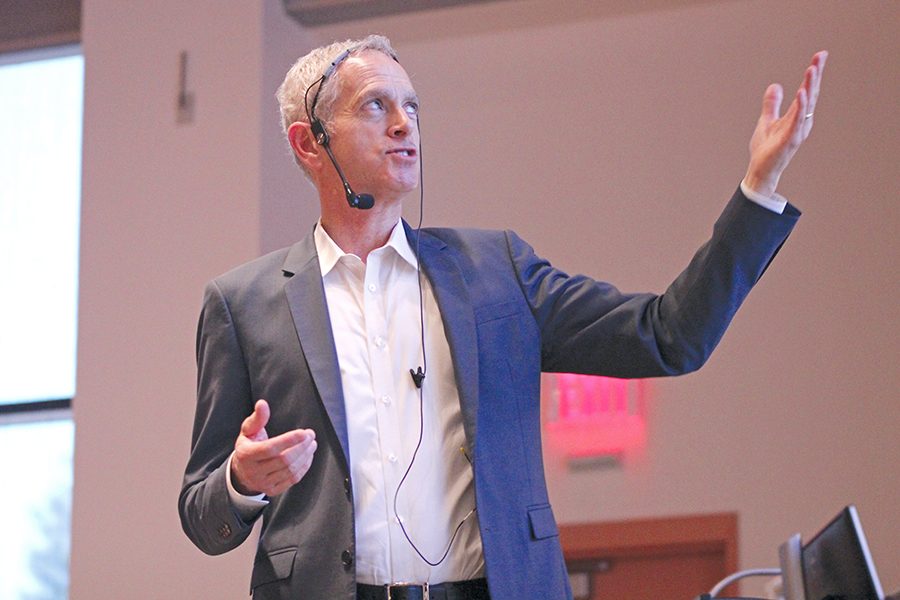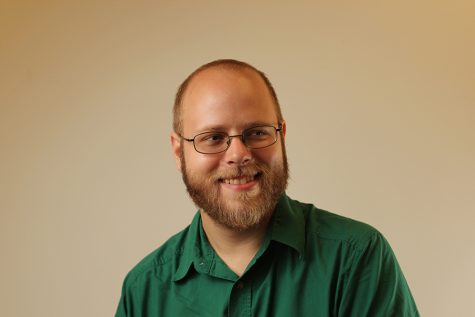Author of Nobel Prize laureate explains climate issue
Center for Science Excellence hosts climate change panel
Christian Urrutia / The Advocate
The lead author of a Nobel laureate report William Collins speaks to audience members during his visit in GE-225 on Friday. Collins presented data on climate change and greenhouse gases.
Sep 16, 2016
The co-author of a report that earned a Nobel laureate spoke in GE- 225 Friday on the state of the climate, and the consequences if humanity fails to act.
William Collins said what he had to show the approximately 110 attendees at Contra Costa College was “not my own work, but the results of many, many people.”
Collins was a lead author of the fourth Intergovernmental Panel on Climate Change assessment report that won the Nobel peace Prize in 2007. The report combined the work of more than 2,000 scientists in fields ranging from chemistry and physics to biology and paleontology.
“Climate science is really an international effort,” he said.
Collins said, “The very first person who predicted climate change did it in the 1880s with a pencil and paper.” He said it isn’t hard to work out that climate change will happen. “(Now) we use very basic physics to build very fancy models.”
Collins said data about past climates, before modern record keeping, has to be collected through proxy records like fossils, ice cores, tree rings and pollen. The tree rings are useful because the thickness of each year’s growth is shown in order and gives information on local temperature and precipitation.
The ice cores, taken from places like Greenland and Antarctica, catch volcanic ash, and trap pockets of air that can be analyzed for Carbon Dioxide content. The pollen is collected from various sources, including the pollen sacks of bees that were trapped in amber. Pollen shows what plants were flowering in the past. He said historical records of harvests and droughts see some use too.
For the future, computer models are needed.
In the present, temperatures are measured directly from satellites and ground instruments.
“In the fossil record we can see how the climate has changed in the past,” Collins said.
The climate has been changed by volcanoes, and solar output. The Sun has gotten fractionally brighter, and there is slightly less volcanic activity. Both tend to slightly raise the temperature. “(But) those explanations can not explain what we’re seeing (now).”
Climate change normally takes tens of thousands of years at least, but Collins said, “We’re making it happen in 200 years,” at over 20,000 times the natural rate.
“The year 2012 was the hottest year in US history. 2016 is stacking up to be the hottest in world history,” Collins said. “Every single month this year is breaking records. July was the hottest month ever recorded.
“We’re hearing more and more about extreme weather—like the floods in Louisiana.”
Collins said he was in Tasmania, off Australia’s coast, working on the fifth IPCC assessment report in 2013. That was the year Australia was ravaged by what came to be called the Angry Summer.
“(The Angry summer) broke 120 (weather) records in 90 days while we were there.”
It was the hottest January on record, the hottest summer, had the hottest day recorded for Australia as a whole, and had seven consecutive days where the continent averaged above 39 degrees Celsius. The Bureau of Meteorology had to add new colors to their chart, which previously stretched to 50 C, to denote temperatures as high as 54 C, 129 degrees Fahrenheit.
Collins said he could see the smoke from the enormous Tasmanian brushfires, and his flight out was nearly cancelled due to the extreme heat.
Collins said the greenhouse effect is mostly a good thing, pointing out that the Moon gets the same amount of sunlight as the Earth.
“Carbon dioxide turns out to be a very powerful greenhouse gas, the second most important greenhouse gas. Without it the earth would become a snowball.”
CO2 is 75 percent of greenhouse gas, and globally CO2 is rising two percent per year.
The fraction of the atmosphere that is CO2 rose by 47 parts per million (PPM) between 1750 and 1970, and 70 PPM since 1970, and is now over 400 PPM for the first time in 4.5 million years.
As far as removing CO2 goes, Collins said, “Mother nature will do it for you, but it will take a really long time.” It isn’t like mere smog, and on average it lingers 120 years. Chemistry teacher Willaim Michaely said it could last as long as 200 years, depending on the area. “We have accumulated a huge debt of carbon,” Collins said.
Collins said, “(California) has enjoyed a very stable, mediterranean climate for about 8,000 years.” All the patterns of our lives, the cities, crops, the cattle are dependent on the climate’s stability. “One feature we’re used to is we don’t get hurricanes. Yet,” he said.
He said heat, water and sea level rise are the ways Californians will experience climate change most.
“Almost the whole (of California) is two degrees warmer than it was historically.
This is what I mean when I say we’re not living in (the same climate anymore),” he said.
“One of the most important changes is (the) snowpack (that) provides approximately 30 percent of California’s water supply. When you heat the air it tends to melt snow. Even though we’ve been getting about the same total amount of precipitation (the water just runs off into the ocean.)
“None of this is at the point where it’s actively intruding on our lives, but this has been going on for a while. Climate change, as it goes on, it speeds up. The dangerous levels of climate change at about 2 degrees Celsius. We’re about half way there, that’s where major global changes start.
“(Only) ten percent of California’s snowpack will remain by the end of the century.”
Michaely said, “Think about our forests. They’re dead and now they’re burning. (Those) trees can take 100 years to reach full size.”
Collins said, “We’re moving the habitability zones for forests twice as fast as the forests can shift to keep up.” Michaely said, “Areas that can support them are continually moving north.”
Collins said California will not be as hard hit as other areas because the Pacific ocean is a huge buffer, absorbing and releasing extremes of heat.
In fact, he said most heat goes into the ocean. Currently three quarters of sea level rise is from thermal expansion. In the future sea level rise will be split about equally between thermal expansion, and melting land ice and glaciers.
He said, “In the US we think about refugees as a problem affecting places elsewhere in the world. People have become climate refugees in Louisiana and Alaska due to rising waters already.”
The ocean takes a long time to heat up, and therefore a long time to cool down.
“The solutions take longer the more you wait to start,” he said.
The issue of climate change has been unfortunately politicized, and been turned into an almost a tribal issue, he said.
Because of the lag time for the benefits to be visible it has to be sold on side benefits like reduced expenses, better air and energy independence.
The choices we make now (or fail to make) can affect the climate in 2075 enormously.
Collins said, “Not making a choice is making a choice. Choosing to continue business as usual is a terrible choice. At certain point people can no longer ignore it.
“I’m an optimist. We’re very close to being able to produce solar energy at the same cost as fossil fuel energy.”
He said we don’t have to give up cars, or change our lifestyle.
California produces 1 percent of total global emissions, which is low for our GDP, and is twice as energy efficient per capita of the rest of the nation.
Governor Brown has pledged to reduce emissions further. “We think we can reduce emissions by 80 percent by 2030,” Collins said.




Dr. Philip Haddad • Sep 18, 2016 at 9:32 am
It is very clear that global warming started around 1920 ( see http//www.pbs.org/wgbh/warming/etc/graphs.html.). It should be noted that CO2 was 300 ppm and was not the cause. The real cause was the heat produced by the burning of the fossil fuels which has increased 20 fold since then. Why is it so hard to understand that heat produced by fossil and nuclear energy must increase air and water temperatures if the amount exceeds the solar energy that is absorbed by photosynthesis? The amount of accountable heat is more than four times the amount that can be attributed to the rise in air temperature, not to mention that from unrecorded sources such as gas-flaring, forest fires etc.. It is enough to prevent the dissipation of 44 terawatts of geothermal heat flow which then builds up in the land and water. The addition of 100 ppm of CO2 to the greenhouse blanket is of minor consequence as compared to the tremendous increase in heat released below this blanket. The melting of glaciers and snow pack has decreased the reflected solar heat which exacerbates the cycle of melting and absorbing more heat. Indeed the findings of Levitus et.al 2012 indicate a recent rate of rise ocean heat content to exceed 250 terawatts annually, an amount that cannot be accounted for by the total for energy consumption, geothermal heat flow, or even the small incremental increases in CO2. There is no questioning the dramatic effects global warming is having, but there is still no recognition that heat, and not CO2, was the initial cause. Even with a total replacement of fossil and nuclear energy with renewables it may not be possible to reverse the trend.
kramer • Sep 18, 2016 at 7:09 am
Collins is not a Nobel laureate.
His work contributed to the IPCC report which was awarded a Nobel. That does NOT make him a Nobel laureate. Please correct the article.
http://www.ipcc.ch/pdf/nobel/Nobel_statement_final.pdf
b lemon • Sep 18, 2016 at 6:20 am
Check the list of 2007 Nobel Prize winners…
He is not one an falsifying credentials
He – or your reporter – is lying.
Roxana Amparo • Sep 19, 2016 at 4:51 pm
Thank you for the comment.
We updated the information.